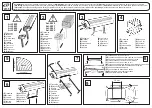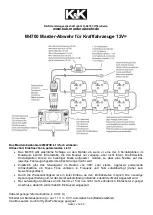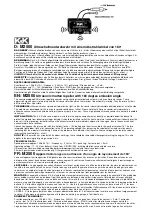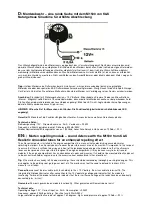
The unit will not turn off lights when
power is initially applied until the time
delay period (6 to 15 minutes) has
passed. You may shorten this time to
30 seconds by inserting the ByPass
key half way.
Detection Test
1. Walk to an area of the room where
normal activity will occur. Remain
motionless for 5 seconds. This 5 sec-
ond period allows the Red LED Test
Circuit to recharge. Move one arm
until the LED blinks. This indicates
that your movement has been detect-
ed.
2. Move to other areas. Repeat
the test.
LED will blink when sensor
detects movement
Time Adjustment
The LOS2400 allows adjustment
of the delay time from 6 to 15
minutes.
If no movement is detected for the
time period selected, the lights turn
off. The Time Adjustment is factory set
for 12 minutes.
The Time should be reduced only in
heavy traffic areas such as hallways,
kitchens, copier rooms, etc. to achieve
maximum energy savings.
Keep the time setting at maximum in
large rooms (over 400 sf).
The time delay can be shortened to
30 seconds for testing by inserting the
ByPass key half way.
LED
Adjustment
Sensitivity Adjustment
Adjusting the Sensitivity control is not
normally necessary. It can reduce
detector sensitivity 5%. Less sensitivi-
ty may be desired for smaller rooms
(less than 400 sf).
If the unit is being activated by HVAC
or other infrared sources (other than
people), reducing the sensitivity may
help.
Masking The Lens
If the sensor’s location gives it a view
of other rooms or hallways, lights will
be turned on when movement is
detected in these adjacent areas. The
sensor’s detection zone may be
restricted by covering a portion of the
lens with the masking elements pro-
vided. Make sure the sensor is not
“seeing” people in other rooms or hall-
ways through open doorways. Mask
the lens in the direction of the door.
Temperature Stabilization
If the sensor was in transit and
subjected to extreme heat or freezing
before installation it may take up to an
hour for the sensor to reach room
temperature and operate normally.
Maintenance and Repair
The LOS2400 requires no maintenance
other than keeping the lens area clean
and free of obstructions. Do not attempt
to open or repair the unit. There are
dangerous voltages inside the case
and no user serviceable parts. For
repair service, follow the instructions
in the limited warranty section.
ByPass Key
In the unlikely event of unit failure, insert
the ByPass key completely on the side
of the unit. This will bypass all electronic
circuitry and keep lights on all the time.
Temperature Variation:
This is a passive infrared sensor
that detects changes in temperature.
Dramatic changes in temperature can
activate the lights.
5
6
Bypass
Logic
Key
Masking Segment “A” Installed
Masking
Segments
15 Min.
6 Min.
Min.
(100%
Min.
(95%






















